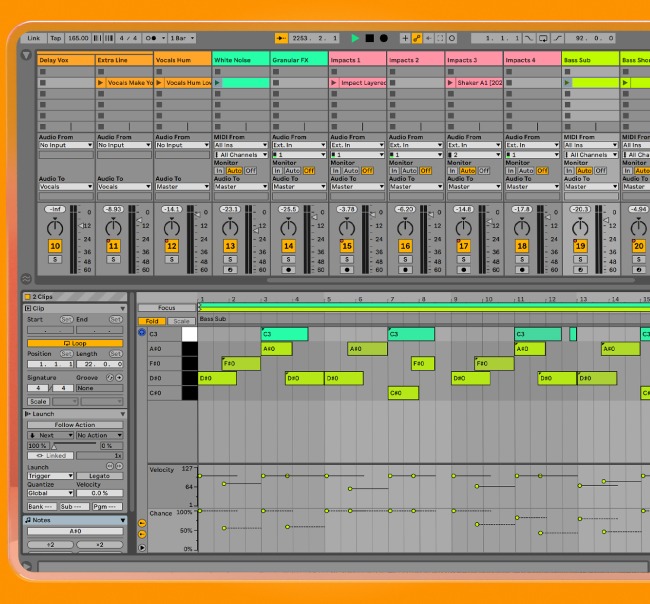
How to Make a Travis Scott Type Beat

Travis Scott is maybe the biggest rapper in the trap game.
His signature beat style is almost its own genre by this point. It’s no wonder so many producers want to create beats with the same vibe and energy.
But getting it right isn’t easy. Many of the music production tricks used to create this type beat take practice.
Even so, you can build your own Travis Scott type beats if you know a few basic techniques.
In this article we break down a Travis Scott type beat by lil soy sauce and show you everything that went into making it slap.
1. Set the mood with atmospheric samples
Travis Scott beats usually have a dark and brooding atmosphere. To build your own you’ll need to layer some ambient samples to create a complex mood.
Ethereal sounds, reverb washes and eerie textures should hang in the background of this type of beat.
If you’re looking for some moody SFX samples to use in a Travis Scott type beat, check out this pack roundup for the top picks.
When it comes to ambience, your samples should be felt more than heard. Use reverb, panning and EQ to keep the atmosphere from interfering with the rest of the beat.
2. Use a synth for the main loop
Travis Scott beats often feature a moody synth or keys melody for the main loop.
This beat uses an old-school, analog-style synth for a dark sci-fi tone:
Your main loop needs to be catchy and simple but active enough to hold the listener’s attention.
Your main loop needs to be catchy and simple but active enough to hold the listener’s attention.
You’ll also need to create a few variations to shake things up throughout the beat. Make sure there’s enough material to create one or two contrasting versions of the main loop melody.
In this Travis Scott type beat the main synth loop uses a mixture of chords and single notes to make a pattern that adds to the ambient texture with the sustained chords at the end of the phrase.
It’s layered with a higher variation that emphasizes the melodic trill every few bars.
3. Use one-shots for tags and risers
There’s no good Travis Scott type beat without a Sicko Mode-style beat drop.
You’ll need a nice subtle riser to bring the intensity up for the first verse. In this beat, a wide noisy burst of sound hypes up the energy without adding a new chord or melody.
There are tons of suitable risers to choose from LANDR’s collection of Travis Scott type sample packs, so you should have no trouble choosing a few to add to your beat.
Drop a riser sample anywhere your beat needs to ramp up, but don’t go overboard—keep these for biggest payoffs in the track.
You’ll also need a one-shot or two for a tag to help kick off the verses.
This beat uses a heavily processed vocal sample to set up each verse with a ghostly disembodied voice.
4. Bring in real instruments
The retro polysynth is perfect for the cold, distant sound of this beat’s main hook.
But bringing in more organic instruments during the verse can help clear out the space and emphasize the vocal.
Bringing in more organic instruments during the verse can help clear out the space and emphasize the vocal.
It’s also a great opportunity to write a countermelody that keeps the beat fresh.
In this beat the flute weaves a nice compact melody that fades into the background of the verse.
You can always use a real flute sample, but this beat uses a vintage Mellotron sound instead.
Pulling out the main loop or simplifying the drum pattern are great ways to thin out the beat so the vocals can take over.
The Mellotron was one of the first sampling instruments ever made. It was a giant contraption that used individual lengths of analog tape to play an instrument sound on each key.
The unique sound of its lo-fi analog tape brings a dusty, lived-in feel to the flute sound that goes perfectly with the beat.
With the main loop out you can also hear a faint Mellotron harp melody arpeggiating in the background.
5. Keep the drums minimal, but make sure they slap
Like any good trap beat, you’ll need some hard hitting 808 samples for the foundation.
Travis Scott drums often use an 808 kick that’s fairly distorted and crunchy.
The saturation makes it easier to hear sources with lots of sub bass in a dense mix. It also helps emphasize the fundamental frequency of the 808 sine wave so the bass melody pops.
In this beat the kick comes from Surge Sounds’ Astro sample pack and the 808 bass comes from Tha Myind’s Myind Wavs pack.
The 808 bass is tuned into a minimal bassline using Simpler and has a nice long decay so it rings out underneath the instrumental.
There’s also some classic trap hats and a nice biting clap that cuts through the mix without taking up too much space.
Panning the open and closed hats apart in the stereo field gives them a more satisfying and sometimes psychedelic sound.
6. Bring elements in and out to shape the song
It might seem like there’s a lot going on in this beat, but just like real Travis Scott instrumentals, it’s meant to feel stripped down.
You can emphasize the minimal feel by bringing elements in and out to keep it interesting.
Pulling out the main loop or simplifying the drum pattern are great ways to thin out the beat so the vocals can take over.
Sicko mode
Travis Scott type beats are in demand among artists and producers.
Once you know how to make them you can get in on the action and even sell your beats online.
If you’ve made it through this article you’ll have a great start for building your own Travis Scott type beat.
Gear guides, tips, tutorials, inspiration and more—delivered weekly.
Keep up with the LANDR Blog.







